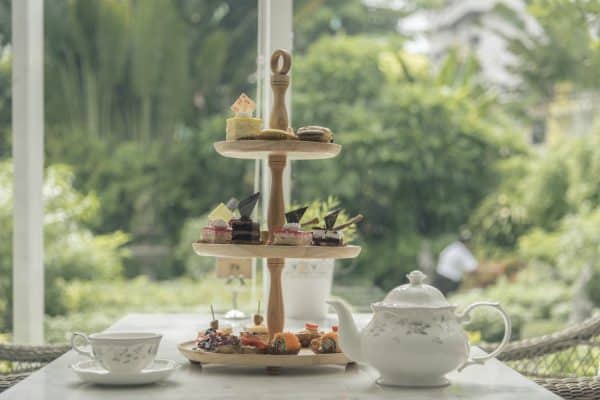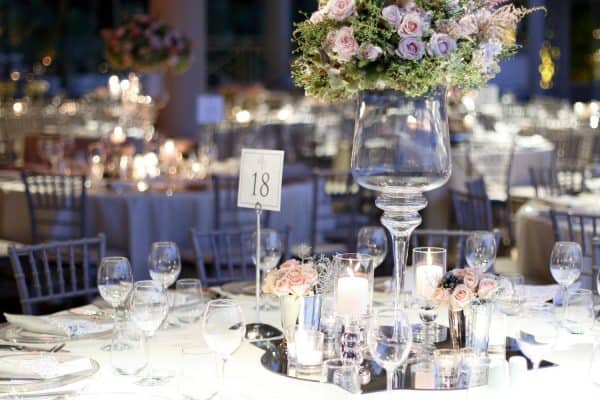That’s it folks, summer is officially over for another year. The Autumn Equinox on September 23rd signals the end of the sunny season and the start of the autumn. However you feel about declining temperatures and reduced daylight hours, some things about the autumn do have a certain charm. Not least of which is the food! We’ve collected some of our favourite September recipes to embrace the changing seasons with.
Lamb, turnip & celeriac hotpot (from BBC Good Food)
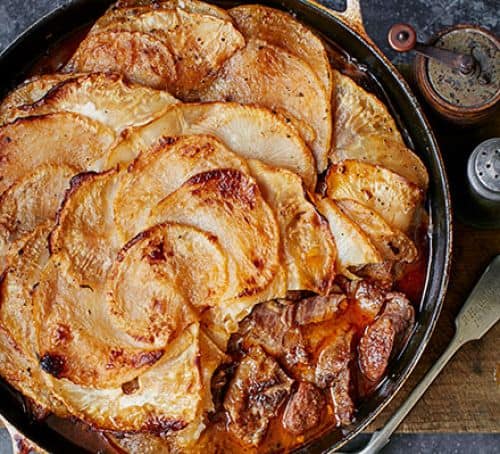
Image courtesy of BBC Good Food
The start of the autumn is the start of many things: the harvest, the countdown to Christmas, and more. For us, though, the start of autumn heralds the start of slow cooker season! This lamb, turnip and celeriac hotpot makes the most of ingredients in season, although it’s definitely a dish to save for a treat!
Serves 6, from £2.11 per serving
What you’ll need
2 1/2 tablespoons of vegetable oil
6 lamb neck fillets – these are much cheaper than other cuts of lamb!
9 shallots
3 tablespoons of plain flour
1 garlic bulb – yep, a whole bulb!
1 litre of beef or lamb stock
3 merguez or frankfurter sausages, sliced
500g turnips (the equivalent of two large ones), peeled and thinly sliced
1 celeriac, peeled and thinly sliced
6 cloves
3 star anise
1 1/2 teaspoons of rosemary
3 garlic cloves
1 tablespoon of Dijon mustard
How to make it
First, combine the cloves, star anise, rosemary, garlic cloves and mustard in a spice blender or pestle and mortar to form a paste. Rub the paste onto the lamb, then pop it in the fridge to marinate for at least 30 minutes, but ideally overnight.
When you’re ready to start cooking, heat your oven to 160 degrees.
Add a tablespoon of oil to a large, flameproof casserole dish and heat it on the hob until the oil is smoking. Sear the lamb in the dish until evenly browned on all sides, then set it aside on a plate. The more caramelisation you can get on the meat, the better it’ll taste!
Wipe the dish clean with kitchen paper and add the remaining oil. Once hot, add the shallots and cook for about 5 minutes until browned. Then, add the flour and cook for just one minute.
Add the garlic bulb and the stock to the dish, giving it a good stir to make sure the flour is incorporated, and bring it to the boil. Return the lamb to the dish, along with the sausages. Cover with a tight fitting lid, pop in the oven, and leave to cook for two hours.
Once the two hours are up, remove the hotpot from the oven and place slices of turnip and celeriac on the top, overlapping them as you layer them up. Press the first couple of layers into the delicious sauce so that they soak up the juices! Put the hotpot back in the oven for 1 1/2 hours until the top is golden, and the sauce is bubbling up around the sides.
Serve with mashed potatoes and red cabbage.
The ultimate leek and potato soup (from Delicious)
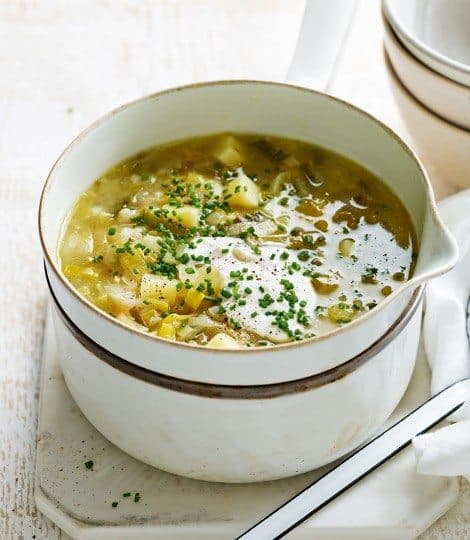
Image courtesy of Delicious Magazine
If you’re not eating a hearty meal from the slow cooker as soon as the weather shows signs of autumn, you’re probably tucking into a nice, warming soup. Both leeks and potatoes are in season throughout the winter months, so make the most of the crops with a leek and potato soup – one of our favourite September recipes!
Serves 8, from £0.76 per serving
What you’ll need
500g leeks, finely chopped
2 onions, finely chopped
600g maris piper potatoes, finely diced
2 garlic cloves, crushed
1 litre of vegetable stock
1 teaspoon of dijon mustard
A small bunch of fresh chives, finely chopped
Crusty bread, to serve
How to make it
In a large, non-stick saucepan, melt a little butter over a medium heat, and add the leeks, onions and potatoes, seasoned generously with salt and pepper. Pop the lid on, and leave them to cook for 15-20 minutes. Stir every now and then to make sure the veg doesn’t stick to the bottom of the pan. Add the garlic and stir through for a minute to cook.
Next, add the stock and the mustard, bring it to the boil, then turn down the heat and simmer for 15 minutes until the veg is tender. If you prefer a smooth soup, you can take the cooked soup off the heat and blend it. Or, if you’re happy with a chunky soup, serve it straight away. Either way, serve sprinkled in chopped chives with a generous portion of nice, fresh crusty bread.
Mackerel carbonara (from Jamie Oliver)
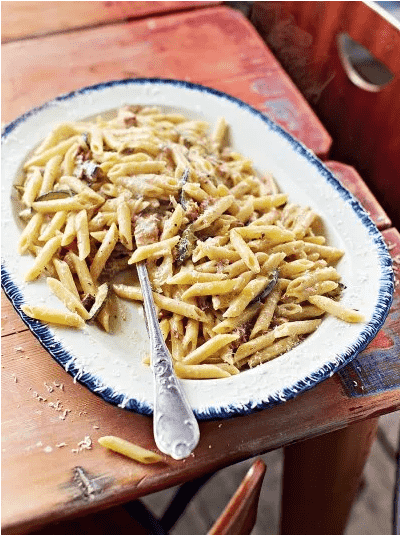
Image courtesy of Jamie Oliver
Mackerel is a cost effective seasonal alternative to salmon that’s packed full of nutritious fatty acids and omega 3. In this carbonara, smoked mackerel takes the place of traditional pancetta or bacon to keep the smoky flavour carbonara is known for, while packing a bit more of a nutritional punch.
Serves 4, from £0.51 per serving
What you’ll need
320g dried penne pasta
1 onion
1 large courgette
2 sprigs of fresh rosemary
130g smoked mackerel fillets – bonelss
Olive oil
2 large free range eggs
100ml semi-skimmed milk
40g parmesan cheese
How to make it
Cook the penne according to the instructions on the packet – we recommend adding a drop of olive oil to stop the pasta from sticking together.
While the pasta is cooking, peel and finely slice the onion. Then, cut the courgette into quarters, and cut out the fluffy middle so you’re left with the firm part. Slice each quarter at an angle, so you have pieces roughly 1cm thick that look a bit like a piece of penne. Put the onion and courgette into a large frying pan on a medium heat with a generous drizzle of oil and cook for 5 minutes, stirring occasionally.
While the veg is cooking, slice the mackerel into pieces 1cm thick, removing the skin as well if you prefer, then pick and chop the rosemary leaves. Add the fish and rosemary to the frying pan and cook for another 5 minutes until everything is nice and golden. Toss the pan every now and then to prevent sticking. When time is up, take the pan off the heat.
During this second 5 minutes, whisk the eggs, milk and grated parmesan together in a measuring jug.
Drain the pasta, reserving a cup of the cooking water. Toss the cooked pasta into the mackerel pan with a good splash of the cooking water to help cool the pan down. This is important to make sure the eggs stay silky and don’t scramble when you add them to the sauce!
Quickly pour the egg, milk and cheese mixture into the pan and stir it all together until the mackerel and pasta is evenly coated all over, and the sauce is nice and thick and silky.
Serve with an extra pinch of parmesan, a generous pinch of black pepper and a squeeze of lemon juice, if you like!
Perfect apple and blackberry crumble (from The Guardian)
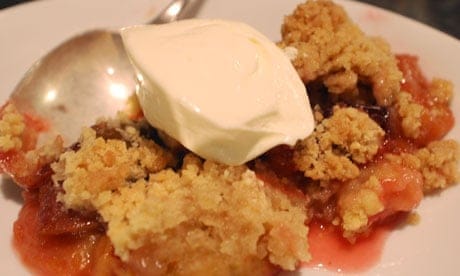
Image courtesy of Felicity Cloake
Apple and blackberry crumble is a favourite at this time of year. After all, is there anything more autumnal than a good crumble and custard? Both apples and blackberries are in season by September, so this classic dessert is brilliantly on budget as well!
Serves 6, from £1.53 per serving
What you’ll need
150g plain flour
125g chilled, unsalted butter, sliced into cubes
35g demerara sugar
35g caster sugar
900g apples and blackberries – we suggest using 4-5 apples and then topping up with blackberries. Frozen are much better value for money than fresh, too!
A handful of porridge oats
How to make it
First things first, get your oven on. 200 degrees is the perfect temperature for cooking a perfect crumble. The average oven takes about 15 minutes to pre-heat, which is plenty of time for you to prepare the rest of your crumble.
Next, prepare your apples. They’ll need to be peeled, cored, and chopped into small chunks. Depending on whether you like crunchy apples in a crumble (we don’t), you can soften them in a saucepan with a sprinkle of sugar and a tablespoon of water – this should only take a few minutes.
While your apples are softening, make your crumble mixture by blending the flour, butter and sugars either in a food processor, or by hand. We think food processors make it too easy to over-mix a crumble, so prefer to make our crumble topping by hand. To make it by hand, simply rub the ingredients between your fingers, as though you were trying to open a stubborn plastic bag, until the mixture resembles coarse breadcrumbs. Now is also a good time to add any spices like cinnamon or nutmeg, if that’s something you enjoy!
Mix your softened apples together with your blackberries in a shallow baking dish, and top with your crumble and a sprinkle of oats. Pop the dish into the oven for half an hour until golden and bubbling.
Serve slightly cooled with ice cream or custard.


